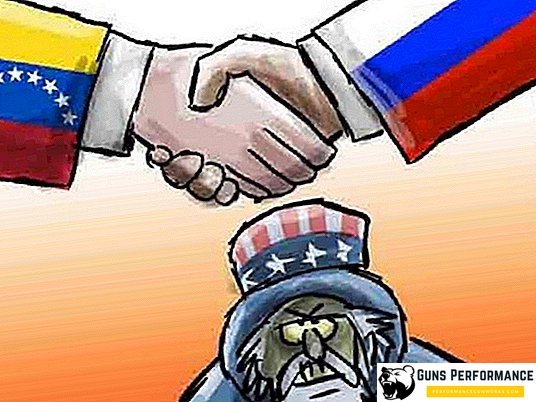
Ragnar Lodbrok is a semi-mythical character. About its existence, scientists argue so far. As a historical character, Ragnar Lodbrok does not appear in the annals, but the Norse sagas indicate that he was a very real person.
The origin of Ragnar Lodbrok
According to the sagas, Ragnar was the representative of the glorious kind of Ynglings, who leads his lineage from the god of sunshine Freyr. Freyr himself is the grandson of the supreme god Odin, which indirectly classifies all his descendants as Odin's blood relatives. Frey was quite a peace-loving god who did not like to fight, and it is he who is considered the ancestor of all the kingdoms of Sweden and Norway.
Despite the fact that Ragnar Lodbrok (thanks to the TV show "Vikings") is considered to be a simple Viking who could "climb" to the king, most likely he was the son of the famous king Danes Sigurd Ring. Sigurd himself was the great-grandson of Skira from the Ynglings. In order to become the king of the Danes, Sigurd had to completely defeat the army of King Harold Bezzuby. So the stories that the "simple" Viking Ragnar Lodbrok managed to become a hero who was able to conquer Paris, to put it mildly, are doubtful.

Why was Ragnar called Lodbrok?
About the biography of the Viking Ragnar can be found in the Scandinavian sagas. Nicknamed "Lodbrok" (which means leather pants), he received, either in childhood or after the first marriage.
- The first legend tells that Ragnar, as a child, hunted in the forest and accidentally fell into a hunting pit that the Vikings dug for a large beast. In this pit accumulated a lot of poisonous snakes, which immediately attacked the future king of the Vikings. This would end the story of Ragnar’s life if it weren't for the tight leather pants. Snakes could not bite through them and the future "sea king" remained to live;
- According to the second legend, Ragnar received his nickname thanks to the cares of his wife. It was she who made him a "magic" leather pants as an amulet. Most likely, the pants were made of thick skins with wool, otherwise the Vikings would not attach such importance to this piece of clothing of their leader. The thick skin perfectly protected from cutting blows with cold weapons, so that, calling her an amulet from injury, Ragnar's wife was right.
Linguists adhere to other theories regarding the origin of the nickname of this legendary or historical character:
- Some believe that the Vikings, nicknamed “Lodbrok”, meant the dark green color of their pants;
- Others believe that this nickname is not related to clothing at all and comes from the distorted name of the river Lodbrik, which translates as “stream of hatred”;
- Another hypothesis says that Icelanders gave the nickname to the king and it was formed from the word "leodbroga", which means "frightening people";
- According to another version, Ragnar went into battle under the banner depicting one of the crows, the companions of the god Odin. His nickname was made up of two words, which together translate as "Destiny" (lod - fate, brog - banner).
Did Ragnar have Rollo's brother
In the popular TV series Vikings, Ragnar has a brother named Rollo. Naturally, Ragnar had a brother and not one (since the kings did not differ in chastity), but Ragnar never had a brother named Rollo.
The real Rollo is a very real character, though he was born about a hundred years later than his so-called "brother" Ragnar. Rollo's biography is documented in the annals, so he is quite a historical person. Rollo adopted Christianity and married the daughter of the king (he was forced to give him his daughter in order to save the kingdom from the raids of the fierce Vikings with Rollo at the head). He soon became king of Normandy and died at the age of 72.
Wives and Children of Ragnar Londbrok
Ragnar was loving enough, and he had only three official wives. According to the tradition of that era, the marriage was regarded by the Vikings as a way to raise their status and strengthen their financial position.
The first wife (the children from whom they did not become famous for anything) became the warrior Lagerta. According to legend, in order to take her as a wife, Ragnar had to fight with a wolf and a bear. Only after the bear was killed, Lagerta agreed to become his wife.

If you make inquiries about the female warriors of ancient Scandinavia, then it becomes clear: the matter did not stop at fighting with wild animals. Ragnar could only take the warrior wife by defeating her in battle.
Having become a jarl, Ragnar divorced Lagert, using a sign as a pretext, allegedly sent by gods who had slandered dogs first and then a bear. The real reason for the divorce, most likely, was Ragnar’s desire to intermarry with the powerful Jarl Harred, whose daughter Torah he took as his wife. The second wife gave birth to Ragnar with two sons and one daughter.
But Ragnar did not stop at this, and leaving his second wife, married for the third time. This time on princess Aslaug, whose father the legendary king Sigurd once killed the dragon Fafnir.

From this marriage, Ragnar had five children:
- Bjorn Ironbok;
- Sigurd the Snake-eyed;
- Ivar Boneless;
- Hvitserk;
- Ragnhild.
The sons of Ragnar grew up excellent warriors, and although there is no historical evidence for the existence of the Ragnarson brothers (the Vikings did not keep records, their main historical sources were the oral sagas), many indirect sources indicate that Ragnar's sons are as real as Ragnar himself.
The most famous son of Ragnar is Sigurd the Serpent in the eye, whose grandson later became king of Norway. Sigurd received his nickname either for a rare pupil mutation, or (more likely) because of a glance that no one could stand. Together with his brother Ivar Bezkostny, they were considered the most cruel sons of Ragnar.
It is believed that only from official marriages Ragnar had at least 11 children. In addition, he did not differ in fidelity, and throughout Scandinavia, he had many illegitimate descendants. A lot of stories about how he has mastered women with cunning confirm this.
The most striking example is the legend of how Lodbrok changed into a woman's dress in order to secretly make his way to the peasant's daughter. This would not be unusual if this story took place in France or Italy. However, for the Vikings to be like a woman meant to incur shame. A real pagan-Scandinavian would never wear a woman's dress. Most likely, this legend is a kind of metaphor, which suggests that for the sake of women Ragnar was ready to step over any moral norms of those times.
Ragnar's Great Expedition to the Land of the Franks

Most likely, Ragnar would not have achieved historical fame if it were not for his victory over the Franks. An illiterate barbarian was able to capture Paris, defeating the most powerful army in Europe at that time.
At war with the Franks, Ragnar caused fear that after his death there would be heroes who could surpass the great warrior. Because of this, Lodbrok took on the most incredible adventures and trips. Possessing incredible leadership skills, Ragnar emerged victorious from the most difficult situations. That is why his luck attracted to the campaign on the lands of Franks robbers-Vikings from all over Scandinavia, when Ragnar in 845 went to the shores of France. About 150 ships with 5,000 Vikings on board went with him. Although it was extremely difficult to control such a gang, Ragnar’s authority and brutality could unite them into one powerful force.
As soon as the army reached France, it was divided into two parts in order to plunder as much land as possible, until the inhabitants left deep into the mainland, fleeing from the ruthless pagans. Ragnar's troops marched down the Seine, and the second part, led by Hasting (Lodbrok's loyal friend), was the Loire. Plundering the surrounding villages, cities and monasteries, the Vikings were soon reunited into one army in order to capture Paris.
The king of the Franks, Karl the Bald, prepared a trap for the northern invaders, placing his army on the two banks of the Seine. But this trick turned against him. A horde of Vikings Ragnar and Hastinga lightning strike crushed half of the Frankish army, and the second half simply could not help them.
To avoid a dangerous battle with the surviving half of the troops of the Franks, Ragnar gave the order to kill all the Franks in full view of the enemy. The Vikings, being recognized as master craftsmen, hung over hundreds of enemies, and the rest were quartered and tortured. The Franks retreated to Paris in horror, and Karl Lysy soon agreed to pay off in order to save the city from being plundered.

On March 28th the Viking army solemnly entered Paris. Karl Lysyu had to pay a huge ransom. True to his word, Ragnar did not touch Paris, but soon returned and plundered all the settlements on the banks of the Seine. The king appointed a huge reward for Ragnar’s head, but no one ventured on such an adventure.
There is an opinion that the capture of Paris by the Vikings was not so much the merit of Ragnar, as a happy coincidence. The Franks at that time were considered the best warriors of Europe, had better armor and weapons, and were also tempered in constant military clashes. On the other hand, the Frankish army was weakened by the internecine war, initiated by the three sons of Louis, who failed to peacefully divide his father's throne. Most likely, Ragnar knew this: besides the fact that he had a commanding talent, he did not disdain the services of hired spies.
The army of francs did not come to a common opinion, which candidate for the throne should be supported. Therefore, it turned out to be simply not ready to repel the lightning strike of bold and tempered northern brigands. In support of this point of view, it would be appropriate to remind you that the previous campaigns of the Vikings to the lands of France were not as successful and looked more like robber raids.

The second campaign of the Vikings ended in failure, as most of the northerners were out of action due to dysentery. The invasion was similar to the usual robber raid of the Vikings, and this time only monasteries and villages were plundered.
One interesting fact concerns Ragnar Lodbrok. In Europe, he was called "The Beach of God." Such a nickname Ragnar received for a special trick, to which he conquered Christian cities. After waiting for the church holiday, or at least Sunday, Ragnar watched when all the knights gathered in the church, after which they easily captured the city and unarmed warriors blocked in the temple.
Despite the fact that the Vikings usually ravaged the city to the ground and killed everyone in a row, Ragnar was more practical in this respect. He forbade to burn the city and kill its inhabitants, if they agreed to pay the ransom. To his warriors, Ragnar said that it was possible to return to the same place in a few years and again take rich booty. And usually he did.
Death of Ragnar Lodbrok

When the children of Ragnar were already adult warriors, he decided to repeat his legendary feat with the seizure of the kingdom. This time he chose Northumbia. This campaign was unsuccessful for the old king. The warriors of King Ella captured Ragnar in captivity and betrayed a painful execution in a pit of poisonous snakes. There are several versions of why the army of Ragnar lost this battle:
- According to the first version, the Viking fleet hit the storm and was almost completely destroyed, and the surviving Vikings were easily finished off by the soldiers of the English king. Considering the experience of Vikings in navigation, it is rather difficult to believe in this option;
- According to the second version, the ship with Ragnar, sailing near the shores of Northumbia, ran aground and sank. Floated Lodbroka easily captured;
- The third version is striking in its arrogance, but knowing the character of Ragnar, you can easily believe in it. Ragnar went for a ransom to Northumbia on a single ship. He was so confident in his abilities that he had no idea that they would kill him. The captured Ragnar haughtily demanded to release him immediately and pay a ransom for the insult that King Ella inflicted on him.
Dying from the bite of a poisonous snake, Ragnar said (in the hope that these words would tell his sons) the following words: "Here are my pigs grunting when they learn about the death of the old boar!" It is not known whether these words were true or added by skalds, but the sons of Ragnar really cruelly executed King Ella, who killed their father.

Revenge of the Sons of Ragnar Lodbroka
Upon learning of the death of their father, the Ragnarsons were engulfed in noble fury. Their father died as a slave, they did not even give him a weapon in their hands, thereby depriving them of the opportunity to get to Valhalla. Having collected a many thousands army, they set off on a great expedition to the lands of the British. In 867, the combined army of the sons of Ragnar invaded Northumbia, defeated Ella's army on the move, and he himself was betrayed by a painful execution.
Not satisfied with this, the brothers moved on and ravaged most of England. This fact is historically confirmed and is called the “Great Pagan Army”, although some historians doubt that the death of Ragnar Lodbrok was the reason for the beginning of the Danish expansion.
The Viking invasion lasted 4 years, and was stopped by King Alfred, who for this received the title “Great” during his lifetime.












